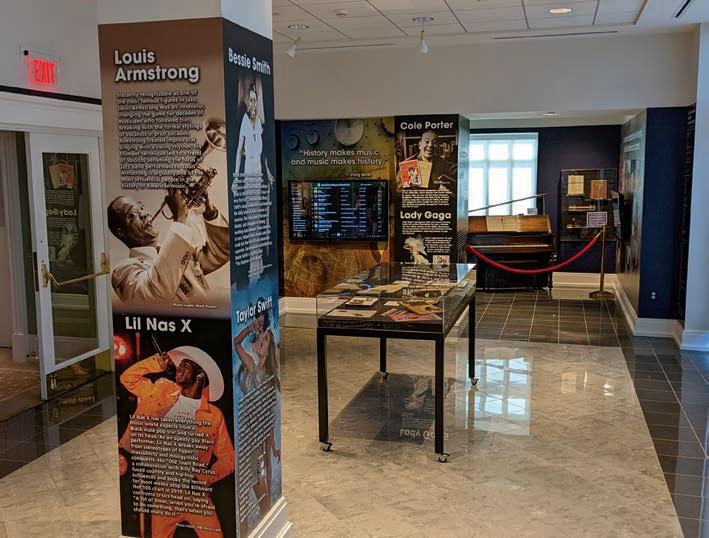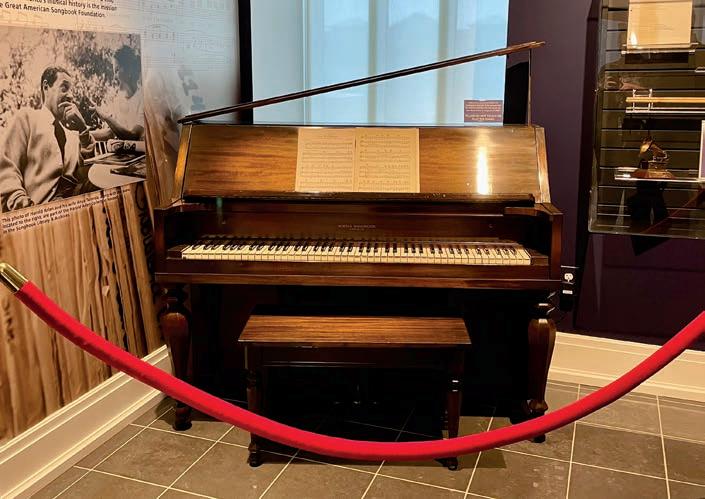
7 minute read
The Great American Songbook Is Still Being Written
Writer // Janelle Morrison • Photography // Courtesy of The Great American Songbook Foundation
Advertisement
I think most of our readers know that I am a champion of the arts, but I have to admit, until recently, I had not spent quality time in The Songbook Gallery, and what I experienced and learned during that visit was truly mind-blowing. It is my hope that all of our readers visit it—in person or virtually—and take advantage of all that the current exhibit, “From the Jazz Age to Streaming: The Soundtrack of the 20s–20s,” has to offer.
The Great American Songbook Foundation’s Executive Director Chris Lewis shared with me the purpose of this particular exhibit as well as information about the foundation that may not be well known to those outside of its organization and supporters. We also discussed how the Great American Songbook continues to expand its pages in each new era, preserving artists’ legacies of yesterday while documenting notable artists of today, to share with the generations of tomorrow.
“Our mantra has always been there’s no reason to save these things if people don’t see them, share them and learn from them,” Lewis expressed. “So, that’s a big part of our mission, and that’s what we’ve been trying to do on an even broader scale.”
What Is The Great American Songbook Foundation?
With a mission to inspire and educate by celebrating the music that many have now coined the “Great American Songbook,” The Great American Songbook Foundation (GASF) is a 501(c)(3) nonprofit organization that is unique in its focus and ambitious in its efforts to become the authority in regard to the history, culture and continuing artistic legacy of America’s original popular song. The Great American Songbook is an enduring canon of the most important and influential American popular songs and jazz standards that began in the early 20th century and is expanding into the 21st century.
In addition to curating exhibitions, GASF’s mission also includes building upon The Great American Songbook Archives & Library that preserves 300plus collections and physical artifacts of the Songbook. For example, I stood less than 5 feet away from the actual piano that Harold Arlen worked from and wrote several familiar standards from, including “Over the Rainbow.” Lewis explained that this is a fairly recent acquisition for GASF. To stand in front of and look over this magnificent artifact was a sensational moment, to say the least.
GASF’s archives also included over 12,000 items from the Meredith Willson collection that have been digitized and are available via digital scrapbook and online exhibit. The archives have drawn in researchers from more than 10 countries who have visited the Songbook Archives for research on a variety of projects, such as the BBC documentary “The Andrews Sisters – Queens of the Music Machines” and “The Music Man” Broadway revival starring Hugh Jackman.
“We have an 8,000-square-foot [offsite] building where we warehouse everything,” Lewis shared. “We’ve had researchers here from over 10 countries and have hosted conferences, including two international musicology conferences, here [at the Center for the Performing Arts], and people have come from Oxford University Press and the Library of Congress and have convened here because we are the home of the Great American Songbook.”
GASF is proud to have formed the Exhibit Alliance with local cultural institutions: Indiana Historical Society, Kurt Vonnegut Library, Carmel Clay Public Library, Indianapolis Public Library and Carmel Clay Historical Society. GASF also produces The Songbook Academy—a national summer intensive for high school-aged singers who have an interest in classic Broadway, jazz and popular music. And GASF is extremely proud to be a Grammy Museum Cultural Affiliate, joining an elite group of institutions worldwide.

Now in its 10th year, the Great American Songbook Hall of Fame serves to elevate the Great American Songbook, much like the Rock & Roll Hall of Fame and the Country Music Hall of Fame have done for their respective musical genres. The Great American Songbook Hall of Fame inducts new members annually, including lyricists, composers and performers who created the soundtrack of our lives.
GASF Exhibitions
The Songbook Gallery is an interactive multimedia space that features public exhibitions of materials curated from its archives and on loan from other collections. Audiences have enjoyed interacting with past exhibits accessible online.
Traveling and virtual versions are available free for use by schools and community groups.
“I think we have eight traveling exhibits right now, and for the first time, all eight have been out on the road in three different states,” Lewis stated. “The virtual exhibits are taking off as well. Where we might get 10,000 people a year through the gallery, we’ve had hundreds of thousands [of people] that view the virtual and the traveling exhibits.”
The current exhibit, “From the Jazz Age to Streaming: The Soundtrack of the 20s–20s,” juxtaposes the popular music and pop culture of the 1920s and the 2020s in terms of how music has been recorded, marketed, purchased and experienced and how the music has reflected the social disparities and other trends of its time.
At the beginning of the 2020s, the issues of today seem uncannily familiar: conflicts in the Middle East and Afghanistan, the coronavirus pandemic, political tensions, racism and immigration laws dominate our headlines now as they did a century ago. But in the midst of turmoil, artists and musicians continue to push boundaries, stretching their creative skills to challenge and excite their audiences.
Though we are separated from the 1920s by a century, today’s artists draw inspiration from their predecessors. Today’s musical artists may be producing albums, making very different types of music while utilizing modern-day technologies, as compared to their 1920s counterparts, but we can see similarities in the creativity and ingenuity as well as the breaking of stereotypes and the pushing of boundaries across the board.
Visitors can look forward to learning about featured artists from Louis Armstrong and Cole Porter to Taylor Swift and Lizzo, viewing “Over the Rainbow” composer Harlen Arlen’s personal piano and engaging with interactive touchscreens to experience the music of the two decades.
“We got our first NEA [National Endowment for the Arts] grant for this exhibit,” Lewis said. “They liked the concept, and it’s been really exciting to see the parallels and similarities between the 1920s and what’s been happening in the early 2020s. It’s a renaissance of creativity and another example of the power of the arts. People clung to the arts and to music during COVID. Everybody wanted to make something, create and share something. And it connected us in a whole new way. I can’t wait to see what really comes of this time relative to art.”
Lewis continued, “Our job is to talk about how the past and present are connected. Lady Gaga speaks very eloquently about her influences and why she has an affinity for jazz and the great singers. Billie Eilish credits her love of music to Peggy Lee.”
Lewis explained that GASF focuses a lot on the “foundational” era of music for the reason that the materials are endangered and have a finite window before they disappear, disintegrate and become lost to time.
Lewis added, “Arts education programs are being cut, and so many students are not learning about our great composers, lyricists and performers and our music history, so that’s another reason why we exist. We also celebrate contemporary artists, and we foster the talents of the next generation.”
While the Great American Songbook term is associated with the “Golden Age” of American popular music, Lewis emphasized that the Songbook is still being written and that contemporary artists such as Billy Joel, Carole King, James Taylor, Elton John, etc., have written popular songs that are 50 years old and are still being played and rerecorded.
Lewis added, “If we’re still singing it, and it’s still being played—it’s part of the American Songbook.”
Plan Your Visit
Be sure to visit the current exhibit, “From the Jazz Age to Streaming,” at the Center for the Performing Arts, in the Songbook Gallery. Admission is FREE!
The gallery hours are Monday – Friday, 10 a.m. – 4 p.m. Enter the Box Office entrance and ask the staff to call a docent down to take you on an exhilarating tour!
As part of the interactive exhibit, you’ll be encouraged to take a three-question quiz, after which you’ll unlock a digital collection of music curated based on your answers to the music quiz!
You can also see a virtual version of the current exhibit, “From the Jazz Age to Streaming,” online at thesongbook.org/ exhibits.




